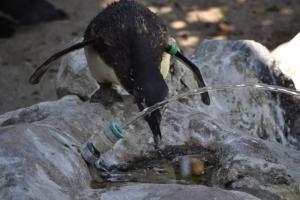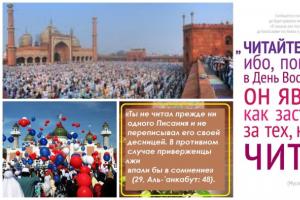We have collected 103 facts about the human body that will delight and surprise you!
Man is a unique creation. All the capabilities of the human body are still unknown. And those that we learn about from scientific research are amazing and make us think. We have collected 103 facts about the human body that will delight and surprise you!
- The only part of the body that does not have a blood supply is the cornea of the eye. It receives oxygen directly from the air.
- The capacity of the human brain exceeds 4 terabytes.
- Up to seven months, the baby can breathe and swallow at the same time.
- Your skull is made up of 29 different bones.
- When you sneeze, all body functions stop, even the heart.
- A nerve impulse from the brain moves at a speed of 274 km/h.
- One human brain generates more electrical impulses in one day than all the world's phones combined.
- The average human body contains enough sulfur to kill all the fleas on an average dog, carbon to make 900 pencils, potassium to fire a toy cannon, fat to make 7 bars of soap, and enough water to fill a 50 liter barrel.
- The human heart pumps 48 million gallons of blood in its lifetime.
- 50,000 cells in your body are dying and being replaced by new ones as you read this sentence.
- The embryo acquires fingerprints at the age of 3 months.
- Women's hearts beat faster than men's.
- Humans are the only creatures that sleep on their backs.
- Right-handed people live on average nine years longer than left-handed people.
- About two-thirds of people tilt their heads to the right when kissing.
- A person forgets 90% of his dreams.
- The total length of blood vessels in the human body is approximately 100,000 kilometers.
- In spring, the respiratory rate is on average one third higher than in autumn.
- By the end of life, a person remembers on average 150 trillion bits of information.
- 80% of the human body's heat leaves the head.
- When you blush, your stomach turns red too.
- Thirst occurs when water loss equals one percent of body weight. A loss of more than 5% can lead to fainting, and more than 10% can lead to death from desiccation.
- There are at least 700 enzymes working in the human body.
- On average, a 4-year-old child asks 450 questions a day.
- In addition to humans, koalas also have unique fingerprints.
- Only 1% of bacteria cause illness in humans.
- All the people on the planet can be comfortably placed in a cube with a side of 1,000 meters.
- The scientific name for the navel is umbilicus.
- The tooth is the only part of the human body that is incapable of self-healing.
- The average time it takes a person to fall asleep is 7 minutes.
- A right-handed person chews most of the food on the right side of the jaw, and vice versa, a left-handed person chews on the left.
- Only 7% of people in the world are left-handed.
- The aroma of apples and bananas helps the body lose weight.
- The length of hair on the head grown by the average person over the course of a lifetime is 725 kilometers.
- Among people who can move their ears, only one third can move one ear.
- The average person swallows 8 small spiders in their lifetime.
- The total weight of bacteria living in the human body is 2 kilograms.
- 99% of all calcium in the body is found in the teeth.
- Human lips are hundreds of times more sensitive than fingertips. A real kiss increases your heart rate to 100 beats per minute or more.
- The absolute strength of the masticatory muscles on one side is 195 kilograms.
- During a kiss, 278 different cultures of bacteria are transmitted from one person to another. Fortunately, 95% of them are harmless.
- Parthenophobia is the fear of virgins.
- Tooth enamel is the hardest tissue produced by the human body.
- If you collect all the iron contained in the human body, you will only get a small screw for a watch.
- There are more than 100 different viruses that cause a runny nose.
- A kiss of sufficient length is much better than chewing gum at normalizing acidity in the oral cavity.
- You can lose 150 calories per hour by hitting your head against a wall.
- Man is the only representative of the animal world capable of drawing straight lines.
- During a lifetime, a person's skin changes approximately 1000 times.
- A person who smokes a pack of cigarettes a day drinks half a cup of tar a year.
- Women blink approximately 2 times less often than men.
- The human body contains only 4 minerals: apatite, aragonite, calcite and cristobalite.
- A real, passionate kiss produces the same chemical reactions in the brain that skydiving and shooting with a pistol.
- Men are considered dwarfs if their height is below 130 cm, women - below 120 cm.
- Fingernails grow about 4 times faster than toenails.
- People with blue eyes are more sensitive to pain than others.
- Nerve impulses in the human body travel at a speed of approximately 90 meters per second.
- In the human brain, 100,000 chemical reactions occur in one second.
- Children are born without kneecaps. They appear only at the age of 2-6 years.
- If one of the identical twins is missing a particular tooth, as a rule, the other twin will also be missing the same tooth.
- The surface area of human lungs is approximately equal to the area of a tennis court.
- On average, a person spends 2 weeks kissing in his entire life.
- Blondes grow a beard faster than brunettes.
- Leukocytes in the human body live 2-4 days, and erythrocytes - 3-4 months.
- The strongest muscle in the human body is the tongue.
- The size of a person's heart is approximately equal to the size of his fist. The weight of an adult human heart is 220-260 grams.
- From the moment of birth, there are already 14 billion cells in the human brain, and this number does not increase until death. On the contrary, after 25 years it decreases by 100 thousand per day. In the minute you spend reading a page, about 70 cells die. After 40 years, brain degradation accelerates sharply, and after 50, neurons (nerve cells) dry out and brain volume decreases.
- At birth, a child’s body contains about 300 bones; in adulthood, there are only 206.
- The human small intestine during life is about 2.5 meters long. After his death, when the muscles of the intestinal wall relax, its length reaches 6 meters.
- The right lung of a person holds more air than the left.
- An adult takes approximately 23,000 breaths (and exhalations) per day.
- The smallest cells in a man's body are sperm cells.
- There are about 40,000 bacteria in the human mouth.
- There are about 2,000 taste buds in the human body.
- The human eye is capable of distinguishing 10,000,000 shades of color.
- The chemical compound responsible for the ecstasy of love (phenylethylamine) is present in chocolate.
- The human heart creates pressure that is enough to raise the blood to the level of the 4th floor.
- A person burns more calories while sleeping than while watching TV.
- Children grow fastest in the spring.
- Every year, more than two thousand left-handers die due to errors in the operation of mechanisms designed for right-handers.
- It turns out that every three hundred men have the opportunity to satisfy themselves orally.
- A person uses 17 muscles when he smiles and 43 when he frowns.
- By age 60, most people have lost half of their taste buds.
- As you know, people are animals too. However, we are the only ones among them who can copulate face to face.
- When a person flies on an airplane, the rate of hair growth doubles.
- One percent of people can see infrared and one percent can see ultraviolet light.
- If you are locked in a completely enclosed room, you will die from carbon dioxide poisoning, not from lack of air.
- On average, a person spends two weeks of his life standing at a traffic light.
- According to statistics, only one person in 2 billion crosses the threshold of 116 years.
- A normal person laughs five times a day.
- The average person speaks 4,800 words in 24 hours.
- The retina inside the eye covers about 650 square mm and contains 137 million light-sensitive cells: 130 million rods for black-and-white vision and seven million cones for color vision.
- Our eyes are always the same size from birth, but our nose and ears never stop growing.
- In the morning a person is about 8 millimeters taller than in the evening.
- The focusing muscles of the eye move 100,000 times a day. In order for the leg muscles to make the same number of contractions, you need to walk 80 kilometers (50 miles) a day.
- The average person produces almost a liter of sweat per day.
- A cough is an explosive charge of air that travels at speeds of up to 60 mph.
- According to German researchers, the risk of a heart attack is higher on Monday than on any other day of the week.
- Bone is five times stronger than steel.
- It is impossible to sneeze with your eyes open.
- Ingrown toenails are a hereditary trait.
- A normal person will die from complete lack of sleep faster than from starvation. Death will occur after about 10 days without sleep, while from starvation - after a few weeks.
- The average lifespan is 2475576000 seconds, we speak an average of 123205750 words, have sex 4239 times, and secrete 60 liters of tears.
Liquid quantum information matrix technologies are a new breakthrough technology for poly-bio-technical applications that are intensively developing in world practice. In the last years of the last century, a lot of experimental work was carried out in a number of countries, the results of which predetermined the current rapid development of new technologies in Russia, China, the USA, Japan, and European countries. It was found that instead of emptiness, there is a physical vacuum around us with a set of properties that allow the process of teleportation of spatial-structural information signals to environments and objects from various liquid matrices. The reception of these signals is accompanied by a change in the structure and, accordingly, the properties of the liquid phase of media and objects, for example, in water its molecules are rearranged into various clusters, clathrates, i.e. water has memory. During wave transmission, the properties of substances are read from them, and these substances can be placed in the liquid phase of a medium, an object, on the surface of an object, around the medium, touching it, near the medium or object. In some cases, energy quanta from the environment around us are used for transmission, for example, quanta from vacuum particles, radioactive background, cosmic microwave background radiation, natural formations, and technological means. In other cases, generators of all kinds of radiation (UPS) are used when a matrix of matter is placed between the generator and the object. These are various Pulse Power Supplies, the operating mode of which is selected in such a way that spinor polarized waves are present in the radiation. In fact, known electromagnetic fields are used, modulated by the spins of electrons and nuclei of substances used in generators. In some cases, longitudinal waves from generators of ultrasonic or ultrahigh-frequency wavelength ranges are used, which can be modulated by the spins of electrons and nuclei of the matrix substance. We give preference to optical range generators with a wide range of wavelengths of visible and thermal radiation. The spins take on the state - 1.0, +1, forming an information qubit, which, instead of the 0.1 bit, is beginning to be used in computer technology and secure telecommutation systems. In technologies for quantum teleportation of the properties of substances, instead of three spin states, the spin in position +1 is predominantly used, i.e. radiation with right-hand polarization of the spinor field, which has a positive effect on the vast majority of environments and objects. Spinor waves not only contribute to the transfer of spatial-structural information about the substance of the liquid matrix to media and objects, but also have two distinctive features. First, they instantly pass through environments and objects. Secondly, they pass through metals and dry materials such as concrete and wood with virtually no loss. All these materials are only information matrices for spinor waves with a characteristic arrangement of the spins of their nuclei. In fact, energy is spent only on receiving and recording spin waves in liquid media. The typical power value of compact spinor generators (UPS) is from 0.1 to 500 W for processing volumes of environment or objects from 0.1 to 100 cubic meters. m. in a time from 10 minutes to 2 hours. The energy of spin waves is spent on structuring those liquid media that are in the path of spinor radiation.
The British publication The Telegraph told the British several dozen stunning facts about Russia. It turns out that our main delicacy is chicken leg soup “jelly”, and lowering the “ears” of a fur hat is considered shameful if it’s warmer than -20 C outside! So, what is Russia like through the eyes of the British?
1. Astoria - a hotel in St. Petersburg, where Hitler planned to throw a festive banquet in honor of the capture of the city.
2. The largest museum in Russia is the Hermitage, also in St. Petersburg. About 70 cats live there, protecting the treasures from rodents. This tradition was started by Empress Elizaveta Petrovna, daughter of Peter the Great, the founder of St. Petersburg. The museum has nearly 14 miles of marble corridors.
3. “Subbotnik” is the day when residents of Russian cities come out voluntarily to sweep and tidy up the streets. The tradition was started after the revolution, but has survived to this day.
4. The name “Red Square” has nothing to do with communism and comes from the word “red”, which once meant “beautiful”.
5. The icicles hanging from the roofs of houses in Moscow in winter are so huge that the sidewalks are fenced off with special tape. Because icicles will certainly kill you if they fall on your head.
6. The bronze dog at the Ploshchad Revolyutsii metro station has a shiny nose. According to local legend, if you touch it, good luck will overtake you.
7. This is not the only dog sculpture in Russia. There is also a monument to Laika, the dog who first flew into space in 1957.
8. A traditional Russian delicacy is soup made from chicken legs, “jelly”.
9. In Russia they love wardrobes. Don't even expect to get very far in a restaurant, bar, museum or gallery until you check your coat and/or bag at the door. Teams of grandmothers run the show here.
10. There may be a problem with presenting flowers. Before delivery, you must make sure that there is an odd number of them in the bouquet. And only if you are going to a funeral, can you take a bouquet with an even number of flowers.
11. In St. Petersburg, next to the bridge leading to the Peter and Paul Fortress, there is a monument to a hare, whose relatives used to inhabit the island and died during floods. It is considered good luck to throw a coin at it and hit it.
12. The further from the capital, the fewer cars. And people's hairstyles are weirder.
13. Russians are the fourth most drinking nation in the world after Belarus, Moldova and Lithuania. Great Britain is in 25th place.
14. The word “vodka” comes from the word “water”.
15. Life expectancy for men is only 63 years, lower than in North Korea or Iraq. But women live to 75.
16. Itygran Island is famous for Whale Alley - an ancient Eskimo structure made of parallel rows of skulls and jaws of bowhead whales dug into the ground.
17. The Moscow subway is perhaps the most beautiful in the world.
18. Many believe that there is an alternative metro scheme - passages that connect the system of military bunkers.
19. Russians pickle everything: cucumber, beets and former leaders.
20. You can find trees in Moscow hung with iron locks - couples leave them here to prove their love.
21. In the museum, under the monument to the heroic defenders of Leningrad, the metronome is always ticking. This is the only sound that was broadcast on the radio during the blockade so that people knew that the city was still alive.
22. Russians consider it cowardly to lower the “ears” on a fur hat if it is warmer outside -20 C.
23. Getting around Moscow is so bad that rich Russians are hiring fake ambulances to beat traffic jams with sirens on.
24. In the Muzeon art park in Moscow there are a bunch of Soviet statues that turned out to be unnecessary, as well as more modern works.
25. There are 11 million more women in Russia than men.
26. 50% of police officers take bribes.
27. Only twins work in one of the Moscow restaurants.
28. Russia is not only tundra and taiga, you can go hiking to volcanoes.
29. Foreigners have to pay more than Russians for entry to most tourist sites. It's unfair, but there's no use complaining. It’s better to laugh at the fact that Abramovich will pay five times less than you just because he is a citizen of Russia.
30. Postnik Yakovlev - the man who supervised the construction of St. Basil's Cathedral. Legend has it that Ivan the Terrible blinded him so that he would never be able to build anything that could compete with the cathedral in Moscow.
31. Russia has more time zones than any other country - 11.
32. Although the situation has improved significantly, Russian police still have a bad reputation for ID checks, so always carry them with you.
33. One of the biggest mysteries of World War II is the fate of the amber room. The hall, decorated with amber panels with gold leaf and mirrors, was located in the Catherine Palace of Tsarskoye Selo near St. Petersburg. The Amber Room was looted by the Nazis, and further traces of it are lost.
34. Olkhon Island, the largest on Lake Baikal, is a hotbed of shamanism.
35. In the Small Dining Room of the Winter Palace there is a clock on the mantelpiece. They were stopped at 2:10 am on the night of October 25, 1917, when the Provisional Government was arrested by the Bolsheviks. This is the moment when Russia took the path of communism.
36. Mikhail Gorbachev recorded an album of romantic ballads. And Putin has his own DVD on judo.
37. In the 1990s, PepsiCo had one of the most powerful submarine fleets in the world thanks to an agreement with Russia.
38. Russians can visit Helsinki from St. Petersburg without a visa as part of a ferry cruise.
39. There is a beach in St. Petersburg. Near the Peter and Paul Fortress, the so-called “walruses” - people who believe in the therapeutic effect of ice water - swim in winter.
40. Vasilievsky Island in St. Petersburg offers a quirky selection of attractions, including a pair of 15th-century Egyptian sphinxes and a cabinet of curiosities where you can see the skeleton and heart of Peter the Great's personal servant.
41. 1800 skiers and snowboarders descended from Mount Sheregesh in bikinis in winter in an attempt to break the Guinness World Record.
42. The ambitious plans of the Russians include the dream of building a highway connecting the Atlantic and the Pacific Ocean.
43. Russia is home to Europe's longest river, the Volga, 3690 kilometers long, which has more than 200 tributaries.
44. Inhuman forced labor camps (GULAG) can turn into tourist destinations. This controversial plan was announced by the regional tourism department in the Republic of Sakha, in Eastern Siberia.
45. About 10,000 British tourists visit Russia every year. And 90% of them do not travel further than Moscow and/or St. Petersburg.
46. In Uglich (about 125 miles north of Moscow), in 1591, presumably on the orders of Boris Godunov, eight-year-old Tsarevich Dmitry, the youngest son of Ivan the Terrible and the last of the Rurik dynasty, was killed. To prevent popular indignation, investigators were sent from Moscow who determined that the boy fell on a knife and accidentally injured himself.
47. Russia is home to the coldest inhabited place on the planet - the village of Oymyakon. On February 6, 1933, a temperature of -67.7 °C was recorded here.
48. One day the Russians built a round ship.
49. In 1908, the Russian Olympic team was 12 days late for the Games because the country lived according to the Julian calendar, and England lived according to the Gregorian calendar.
50. The Jokang-Sami language of the Kola Peninsula is on the verge of extinction - only two people speak it.
51. You can buy old stamps in small stalls on the streets.
52. Peter the Great loved his toy soldiers so much that he hanged a rat that had the imprudence to bite off the head of one of them. He also introduced a tax on beards.
53. In Russia there is a network of cafes where everything is free, you only pay for the time you stay there. One of these opened in London last year.
54. Lake Karachay is used as a nuclear waste dump, so if you stand next to it for an hour, it will probably kill you.
55. One of the museums in St. Petersburg claims to own an exclusive exhibit - the severed penis of Grigory Rasputin, placed in a glass jar. However, experts doubt that this is a real thing.
After this post, you will be able to entertain a group of friends while showing off your erudition.
The blue whale's arteries are so large that a person could swim through them. The heart of a blue whale is the size of a car. The bubbles from a blue whale's intestinal gases can fit a horse inside.
Penguins have an organ above their eyes that turns salt water into drinkable water (the supraorbital gland). 
Hummingbirds' metabolism is so fast that they need to hibernate (a kind of torpor common to bats, some rats and bears) just to sleep at night. If hummingbirds slept without stupor, they would starve to death in their sleep. If the hummingbird does not wake up when it wakes up, it will go back to sleep and die because its body temperature does not rise to normal. 
Lion tamers use chairs because lions can only focus on one thing they want to attack. And when four chair legs are pointed at the lion, he becomes confused and retreats. 
The concentration of salts and sugars in a coconut is similar to that in the human body. Plus, the insides of the coconut are sterile, which means you can use coconuts for intravenous injections. During World War II, American hospitals in the Pacific practiced coconut drips. Due to the lack of sodium (to fully balance the brain functions), coconuts were not suitable for a long course. 
Bananas actually contain large seeds under the skin, just like bean pods. You can grow a tree from them. And the bananas we eat, Cavendish banana, are just sterile mutants that do not contain seeds, but are a sweet fruit. This means that if the natural method of reproduction through seeds is impossible, then new banana trees can be obtained by cloning: we split off shoots from the old mutant, plant them in the soil, and get a new mutant. Just like with weed: you need a mother plant. If any disease affects the mother plant, then the business can be curtailed.
An interesting fact on the topic: isopentyl (isoamyl) acetate is a colorless liquid with the smell of bananas and peaches. It is a pity that inhaling it causes a sore throat, cough, headache, weakness and drowsiness. 
The carrot was originally purple. The color of Dutch monarchs was orange. So the Dutch experimented with planting carrots until the carrots mutated into orange. Orange carrots have become a symbol of prestige. In the picture: the ancient Persians, the caliphs of the Arab Caliphate and the entire Mediterranean plant purple and yellow, and the Netherlands has red, white and orange. 
However, the royal color is more commonly called purple (Roman emperors wore purple, and Roman senators were allowed to wear a purple stripe on their toga). The only way to obtain purple dye is from shellfish mucus. Something like 10,000 clams need to be squeezed to get 1.5g of purple dye. The main flow of the dye came from the Phoenicians, who actually discovered it. 
Clams? Why not use carrots then?! If you are still interested in the question of dyeing, then using carrots (purple or orange) you can dye silk or wool, but it will not dye cotton or linen. But the berries of phytolacca (polyweed) are often used as ink. For example, the Declaration of Independence was written by them. But the color from the berries is not enough to get such a rich color like ancient clothes. In any case, the nobility had to wear colors that ordinary mortals could not obtain. 
Despite the fact that you cannot drown in the Dead Sea, it is the second place in Israel where people die in the water most often. You may ask what comes first. In the first place is any body of water if you are a Palestinian, and for the rest the Mediterranean Sea or the Red Sea. You can easily find problems everywhere. It’s trite that waves and surf are the most dangerous things for a swimmer. So, the Dead Sea. If you fall face first into the water, the density of the water will prevent you from turning over face up. 
Rain doesn't smell like anything. When it rains, humidity increases, which allows you to perceive odors more clearly. After rain, cement takes on a smell. 
From the moment it was discovered until its classification changed, Pluto did not have time to make even one revolution around the Sun. 
If the history of the Earth is compressed into one year, then humanity appeared on December 31st at 23:00. 
Let's put the events on the timeline: Gagarin's flight and the construction of the pyramids. The interval of Cleopatra's life will be closer to "Let's go!" than to the creation of the pyramids. 
It is difficult for a Mercurian to answer the question when is his birthday. If we wake up in a cozy house on Mercury, drinking Mercury coffee while dew crystals melt in the gentle Sun, we will have a day ahead of us, which by earthly standards will last 176 days. In 87.97 days on Earth, one year will pass on Mercury (one revolution around the Sun). On Mercury, a day lasts twice as long as one year. So when is your birthday? 
Bagpipes, haggis, kilts, whiskey and tartan came to Scotland from outside, although they are now a national flavor. 








